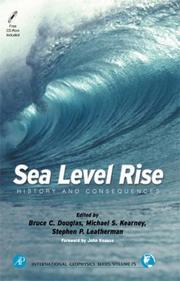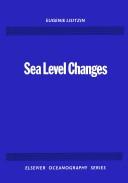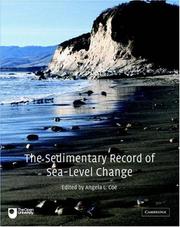| Listing 1 - 10 of 27 | << page >> |
Sort by
|
Book
ISBN: 0128093234 012805414X 9780128093238 9780128054147 Year: 2016 Publisher: Amsterdam : Elsevier,
Abstract | Keywords | Export | Availability | Bookmark
 Loading...
Loading...Choose an application
- Reference Manager
- EndNote
- RefWorks (Direct export to RefWorks)
Paleoclimatology --- Sea level. --- Mean sea level --- Sea level rise --- Oceanography --- Water levels --- Cretaceous Period --- From 65 to 140 million years ago
Book
ISBN: 3030884341 303088435X Year: 2021 Publisher: Cham, Switzerland : Springer International Publishing,
Abstract | Keywords | Export | Availability | Bookmark
 Loading...
Loading...Choose an application
- Reference Manager
- EndNote
- RefWorks (Direct export to RefWorks)
Real property --- Real estate business --- Sea level --- Real estate companies --- Real estate industry --- Business --- Land use --- Real estate investment --- Mean sea level --- Sea level rise --- Oceanography --- Water levels
Book
ISBN: 3038428485 Year: 2018 Publisher: Basel : MDPI - Multidisciplinary Digital Publishing Institute,
Abstract | Keywords | Export | Availability | Bookmark
 Loading...
Loading...Choose an application
- Reference Manager
- EndNote
- RefWorks (Direct export to RefWorks)
Extreme sea levels can lead to hazardous events, such as coastal flooding, erosion, or salt water intrusion, with-wide ranging environmental, societal, and economic consequences. In combination with climate-driven sea-level rise, and, potentially, additional changes in storminess, dynamic wave contributions, and tidal dynamics, the adverse consequences of extreme oceanographic events are expected to escalate in many regions. Integrated coastal zone impact assessments can guide the decisions on the adaptive responses to these changes in the physical environment and for the socioeconomic development of the local communities.
Sea level. --- Coasts --- Environmental aspects. --- Coastal landforms --- Coastal zones --- Coastlines --- Landforms --- Seashore --- Mean sea level --- Sea level rise --- Oceanography --- Water levels
Book
ISBN: 9780128054154 0128054158 0128093250 9780128093252 Year: 2016 Publisher: Amsterdam : Elsevier Science,
Abstract | Keywords | Export | Availability | Bookmark
 Loading...
Loading...Choose an application
- Reference Manager
- EndNote
- RefWorks (Direct export to RefWorks)
Evolutionary paleobiology. --- Marine biodiversity --- Sea level. --- Climatic factors. --- Mean sea level --- Sea level rise --- Oceanography --- Water levels --- Diversity, Marine biological --- Marine biological diversity --- Aquatic biodiversity --- Evolutionary palaeobiology --- Evolution (Biology) --- Paleobiology
Book
ISBN: 1009047906 1009058622 1316517896 1009058428 9781009058629 Year: 2022 Publisher: Cambridge : Cambridge University Press,
Abstract | Keywords | Export | Availability | Bookmark
 Loading...
Loading...Choose an application
- Reference Manager
- EndNote
- RefWorks (Direct export to RefWorks)
Coastal States exercise sovereignty and sovereign rights in maritime zones, measured from their coasts. The limits to these maritime zones are bound to recede as sea levels rise and coastlines are eroded. Furthermore, ocean acidification and ocean warming are increasingly threatening coastal ecosystems, which States are obligated to protect and manage sustainably. These changes, accelerating as the planet heats, prompt an urgent need to clarify and update the international law of maritime zones. This book explains how bilateral maritime boundaries are established, and how coastal instability and vulnerable ecosystems can affect the delimitation process through bilateral negotiations or judicial settlement. Árnadóttir engages with core concepts within public international law to address emerging issues, such as diminishing territory and changing boundaries. She proposes viable ways of addressing future challenges and sets out how fundamental changes to the marine environment can justify termination or revision of settled maritime boundaries and related agreements.
Maritime boundaries. --- Climatic changes --- Sea level. --- Continental shelf --- Submerged lands --- Law and legislation. --- Mean sea level --- Sea level rise --- Oceanography --- Water levels --- Climate change mitigation --- Environmental law --- Liability for climatic change damages --- Boundaries --- Territorial waters --- Law and legislation
Book
ISBN: 3039211986 3039211978 Year: 2019 Publisher: MDPI - Multidisciplinary Digital Publishing Institute
Abstract | Keywords | Export | Availability | Bookmark
 Loading...
Loading...Choose an application
- Reference Manager
- EndNote
- RefWorks (Direct export to RefWorks)
This Special Issue presents the work of 30 scientists from 11 countries. It confirms that the impacts of global change, resulting from both climate change and increasing anthropogenic pressure, are huge on worldwide coastal areas (and critically so on some islands in the Pacific Ocean), with highly negative effects on coastal groundwater resources, which are widely affected by seawater intrusion. Some improved research methods are proposed in the contributions: using innovative hydrogeological, geophysical, and geochemical monitoring; assessing impacts of the changing environment on the coastal groundwater resources in terms of quantity and quality; and using modelling, especially to improve management approaches. The scientific research needed to face these challenges must continue to be deployed by different approaches based on the monitoring, modelling and management of groundwater resources. Novel and more efficient methods must be developed to keep up with the accelerating pace of global change.
tide --- artificial neural network --- Gaza Strip --- groundwater resources --- seawater intrusion --- nutrient discharge --- freshwater resilience --- offshore geophysics --- atoll --- freshwater lens --- sea-level rise --- small islands --- sharp interface numerical modeling --- climate change --- recursive prediction --- saltwater intrusion --- Radon --- submarine groundwater discharge --- water resources management --- flooding --- groundwater storage --- fish ponds --- Tongatapu --- extraction --- monitoring --- modelling --- fresh groundwater volume --- numerical model --- atoll island --- MODFLOW/SEAWAT --- Nile Delta governorates --- arid and semi-arid regions --- time series model --- hydrogeology --- Libya --- sea level rise --- coastal aquifer --- sea–aquifer relations --- Tripoli --- freshwater-saltwater interface --- multi-layered coastal aquifer --- well salinization --- SGD model --- Nile Delta aquifer --- tidal signal --- geophysics --- groundwater --- cation exchange --- salinization --- SGD --- support vector machine --- direct prediction --- aquifer

ISBN: 0444890866 9786611789640 128178964X 0080870961 9780444890863 9780080870960 9781281789648 Year: 1991 Volume: 58 Publisher: Amsterdam ; New York : Elsevier,
Abstract | Keywords | Export | Availability | Bookmark
 Loading...
Loading...Choose an application
- Reference Manager
- EndNote
- RefWorks (Direct export to RefWorks)
This timely study is concerned with the current record of sea-level changes during the past 10,000 years; their rates, and our ability to estimate these changes accurately. The author begins with an extensive introduction to the subject, covering the historical background and the possible causes of sea-level changes and the main methods used to reconstruct former sea-level positions. The second and main part of the Atlas provides a worldwide review of Holocene sea level changes by assembling some 800 local relative sea-level curves, deduced from field data from all parts of the world, and comp
Geology, Stratigraphic --- Sea level --- Atlases --- Atlases. --- Issue --- Geology [Stratigraphic ] --- Holocene --- Sea level - Atlases. --- Geology, Stratigraphic - Holocene - Atlases. --- Mean sea level --- Sea level rise --- Oceanography --- Water levels --- Age of rocks --- Rocks --- Stratigraphic geology --- Physical geology --- Age --- Sea level - Atlases --- Geology, Stratigraphic - Holocene - Atlases

ISBN: 0122213459 9786611059002 1281059005 0080516793 9780080516790 9780122213458 9780122213458 0122213467 9780122213465 9781281059000 6611059008 Year: 2001 Volume: 75 Publisher: San Diego : Academic Press,
Abstract | Keywords | Export | Availability | Bookmark
 Loading...
Loading...Choose an application
- Reference Manager
- EndNote
- RefWorks (Direct export to RefWorks)
Sea Level Rise, History and Consequences includes a special emphasis on the evidence for historical sea level change; case studies are used to demonstrate the resulting consequences. A CD-ROM is included which contain tide gauge data and trends of relative sea level from the Permanent Service for Mean Sea Level. The material on the CD-ROM is either in the form of text files, or web sites that can be opened by widely available web-browsers.Sea level is expected to rise as much as 60-100 centimeters over the next century due to greenhouse-induced global warming
Mean sea level --- Mer [Niveau de la ] --- Niveau [Zee] --- Niveau de la mer --- Sea level --- Sea level rise --- Zeeniveau --- Zeespiegel --- Sea level. --- Water levels. --- Level, Water --- Levels, Water --- Water --- Water level --- Hydraulic measurements --- Oceanography --- Water levels --- Level --- Levels --- Niveau des mers

ISBN: 0444411577 9780444411570 9780080870441 0080870449 1281773727 9781281773722 9786611773724 661177372X Year: 1974 Publisher: Amsterdam ; New York : Elsevier Scientific Pub. Co.,
Abstract | Keywords | Export | Availability | Bookmark
 Loading...
Loading...Choose an application
- Reference Manager
- EndNote
- RefWorks (Direct export to RefWorks)
Sea-Level Changes
Sea level --- 551.46 --- Mean sea level --- Sea level rise --- Oceanography --- Water levels --- Physical oceanography. Submarine topography. Ocean floor --- Sea level. --- 551.46 Physical oceanography. Submarine topography. Ocean floor --- Oceanography. --- Oceanography, Physical --- Oceanology --- Physical oceanography --- Thalassography --- Earth sciences --- Marine sciences --- Ocean --- GEOPHYSIQUE --- GEODYNAMIQUE --- ISOSTASIE, DERIVE DES CONTINENTS, PLAQUES... --- OCEANOLOGIE PHYSIQUE ET CHIMIQUE


ISBN: 0521538424 0521831113 9780521538428 Year: 2003 Publisher: Milton Keynes : Cambridge : The Open University, Cambridge University Press,
Abstract | Keywords | Export | Availability | Bookmark
 Loading...
Loading...Choose an application
- Reference Manager
- EndNote
- RefWorks (Direct export to RefWorks)
This illustrated textbook describes how past changes in sea-level can be detected through an analysis of the sedimentary record, and how sequence stratigraphy techniques can provide explanations of how the sedimentary system evolves through geological time. Designed for use in undergraduate and graduate courses, it includes detailed case studies, set-aside focus boxes, and bulleted Questions and Answers interspersed throughout. The book is also supported by a website hosting sample pages.
Sequence stratigraphy --- Sea level --- Stratigraphie séquentielle --- Niveau de la mer --- 551.312 --- 551.461.2 --- Limnic type. Formation by fresh water --- Sea level (regardless of tides) --- Sequence stratigraphy. --- 551.461.2 Sea level (regardless of tides) --- 551.312 Limnic type. Formation by fresh water --- Stratigraphie séquentielle --- Stratigraphic sequence --- Geology, Stratigraphic --- Geological time --- Mean sea level --- Sea level rise --- Oceanography --- Water levels --- Sea level.
| Listing 1 - 10 of 27 | << page >> |
Sort by
|

 Search
Search Feedback
Feedback About UniCat
About UniCat  Help
Help News
News